Anup Anand Deshmukh
SILK: Smooth InterpoLation frameworK for motion in-betweening A Simplified Computational Approach
Jun 09, 2025Abstract:Motion in-betweening is a crucial tool for animators, enabling intricate control over pose-level details in each keyframe. Recent machine learning solutions for motion in-betweening rely on complex models, incorporating skeleton-aware architectures or requiring multiple modules and training steps. In this work, we introduce a simple yet effective Transformer-based framework, employing a single Transformer encoder to synthesize realistic motions for motion in-betweening tasks. We find that data modeling choices play a significant role in improving in-betweening performance. Among others, we show that increasing data volume can yield equivalent or improved motion transitions, that the choice of pose representation is vital for achieving high-quality results, and that incorporating velocity input features enhances animation performance. These findings challenge the assumption that model complexity is the primary determinant of animation quality and provide insights into a more data-centric approach to motion interpolation. Additional videos and supplementary material are available at https://silk-paper.github.io.
Unsupervised Chunking with Hierarchical RNN
Sep 10, 2023



Abstract:In Natural Language Processing (NLP), predicting linguistic structures, such as parsing and chunking, has mostly relied on manual annotations of syntactic structures. This paper introduces an unsupervised approach to chunking, a syntactic task that involves grouping words in a non-hierarchical manner. We present a two-layer Hierarchical Recurrent Neural Network (HRNN) designed to model word-to-chunk and chunk-to-sentence compositions. Our approach involves a two-stage training process: pretraining with an unsupervised parser and finetuning on downstream NLP tasks. Experiments on the CoNLL-2000 dataset reveal a notable improvement over existing unsupervised methods, enhancing phrase F1 score by up to 6 percentage points. Further, finetuning with downstream tasks results in an additional performance improvement. Interestingly, we observe that the emergence of the chunking structure is transient during the neural model's downstream-task training. This study contributes to the advancement of unsupervised syntactic structure discovery and opens avenues for further research in linguistic theory.
IR-BERT: Leveraging BERT for Semantic Search in Background Linking for News Articles
Jul 24, 2020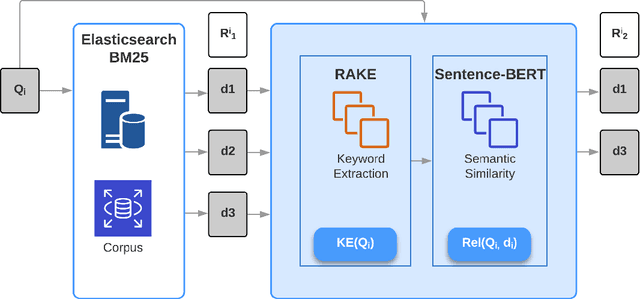
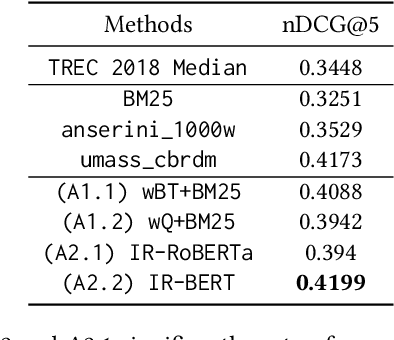
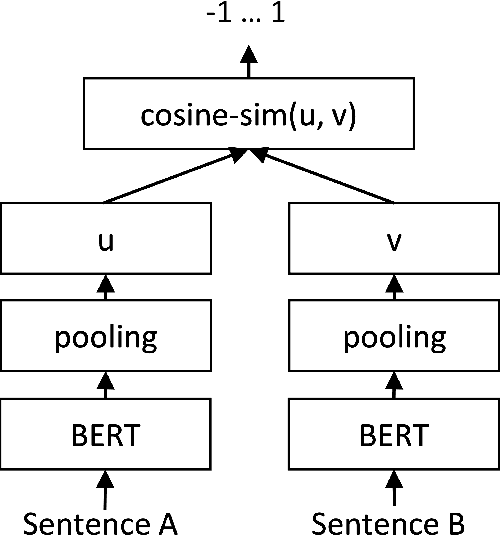

Abstract:This work describes our two approaches for the background linking task of TREC 2020 News Track. The main objective of this task is to recommend a list of relevant articles that the reader should refer to in order to understand the context and gain background information of the query article. Our first approach focuses on building an effective search query by combining weighted keywords extracted from the query document and uses BM25 for retrieval. The second approach leverages the capability of SBERT (Nils Reimers et al.) to learn contextual representations of the query in order to perform semantic search over the corpus. We empirically show that employing a language model benefits our approach in understanding the context as well as the background of the query article. The proposed approaches are evaluated on the TREC 2018 Washington Post dataset and our best model outperforms the TREC median as well as the highest scoring model of 2018 in terms of the nDCG@5 metric. We further propose a diversity measure to evaluate the effectiveness of the various approaches in retrieving a diverse set of documents. This would potentially motivate researchers to work on introducing diversity in their recommended list. We have open sourced our implementation on Github and plan to submit our runs for the background linking task in TREC 2020.
Emo-CNN for Perceiving Stress from Audio Signals: A Brain Chemistry Approach
Jan 08, 2020
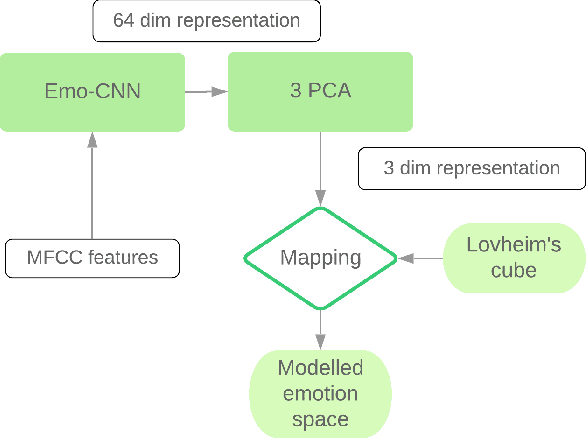

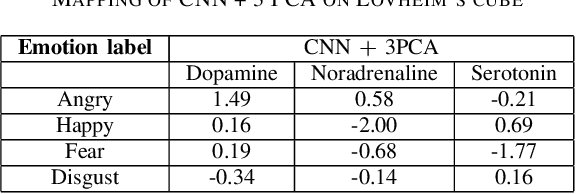
Abstract:Emotion plays a key role in many applications like healthcare, to gather patients emotional behavior. There are certain emotions which are given more importance due to their effectiveness in understanding human feelings. In this paper, we propose an approach that models human stress from audio signals. The research challenge in speech emotion detection is defining the very meaning of stress and being able to categorize it in a precise manner. Supervised Machine Learning models, including state of the art Deep Learning classification methods, rely on the availability of clean and labelled data. One of the problems in affective computation and emotion detection is the limited amount of annotated data of stress. The existing labelled stress emotion datasets are highly subjective to the perception of the annotator. We address the first issue of feature selection by exploiting the use of traditional MFCC features in Convolutional Neural Network. Our experiments show that Emo-CNN consistently and significantly outperforms the popular existing methods over multiple datasets. It achieves 90.2% categorical accuracy on the Emo-DB dataset. To tackle the second and the more significant problem of subjectivity in stress labels, we use Lovheim's cube, which is a 3-dimensional projection of emotions. The cube aims at explaining the relationship between these neurotransmitters and the positions of emotions in 3D space. The learnt emotion representations from the Emo-CNN are mapped to the cube using three component PCA (Principal Component Analysis) which is then used to model human stress. This proposed approach not only circumvents the need for labelled stress data but also complies with the psychological theory of emotions given by Lovheim's cube. We believe that this work is the first step towards creating a connection between Artificial Intelligence and the chemistry of human emotions.
 Add to Chrome
Add to Chrome Add to Firefox
Add to Firefox Add to Edge
Add to Edge